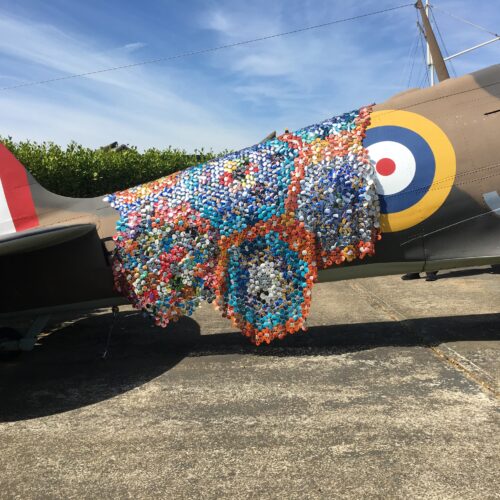
Traditional textile techniques used in contemporary ways – Part 2: Embroidery
The method of decorating the surface of fabric with stitch, to create beauty and express identity is centuries old and traditional to many cultures. In this blog post I hope to bring to your attention alternative ways of thinking about embroidery. As students of textiles you are expected to develop and question conventional methods and aspirations by pushing traditional techniques into new spheres. This might be done by the kind of materials you use, the images you create or the way the work relates to the space. The work you create is part of an evolving tradition where textile practitioners are influenced by the accomplishments of previous generations but you are also responsible for challenging tradition and interpreting embroidery in a new way.

The work of Faig Ahmed explores the traditions and history of the carpets from his native Azerbaijani. He does this by recreating traditionally designed carpets that are also distorted or manipulated in order to encourage the viewer to look more closely. He has taken this a step further by removing the carpet altogether in a large-scale piece titled “thread installation”. Here Faig has embroidered the carpet design into space, using the gallery walls and the atrium of the room to reveal the essence of the object. With only the thread present the piece challenges the nature of embroidery and illustrates the power of stitch.
The collection of works by Iranian born Maryam Ashkanian entitled “epitome” are both distorted and disturbing. Here the artist has used fabric and stitch to create patterns and textures that appear fleshy and grotesque. Maryam uses preparatory sketches to start the creative process but sometimes as the work develops other forces take control and the piece takes on a life of its own. The fabric she uses are old textiles with character and experiences of their own. The stitch work is intricate and numerous, then pulled in all directions to create abstract 3 dimensional compositions.
Inspired by private experiences, lyrics or poems the vibrant works of the Amsterdam based artist Alexandra Drenth are mystical and energetic. She uses a complex combination of hand stitch and fabric collage to communicate feelings, memories and stories. The work decorates surfaces of all descriptions from garments to teacups in a free for all of colour and fantasy. For Alexandra the process of making is like a meditation, working by hand and taking time to create helps her understand herself and the world.
Stories of the details of women’s lives are told though the frank embroideries of the New York based artist Katrina Majkut. She is interested in understanding and exploring feminine narratives. “In control” is a series of cross stitch and mixed media pieces that examine female reproduction and sexual health. Using the traditionally female craft of embroidery Katrina adds another layer of sexual politics to the perceived roles and natural position of women in society. Embroidery skills taught to her as a child and abilities associated with her training as a painter feed into her personal methods of rendering the image onto the fabric.

Not all embroiders use delicate tranquil methods to create their work; Severija Incirauskaite-Kriauneviciene the Lithuanian artist uses power tools to create textile works on metal surfaces. Inspired by domestic objects made kitsch by the adornment of traditional cross-stitch patterns Severija translates this homely cosiness to found metal objects, mixing feminine handicraft with masculine materials. In embroidering onto the bonnet or door of a car the artist is drawing our attention to the sweetness of embroidery but also neutralises it by combining it with the cold metal surface. As with other practitioners who use discarded objects the embroidered surfaces bring to them new life and new meaning.
If you are interested in using embroidery in your own creative practice I suggest you research widely, exploring the approaches of other contemporary practitioners. Be open-minded about the surfaces you stitch into, the places where embroidery can appear, the patterns and designs you create and what can be communicated through stitch.
Bibliography and further reading
Alexandra Drenth. http://www.alexandradrenth.nl/alexandradrenth/drenthembroideries.html
Alexandra Drenth. Italia Art Magazine http://www.italiaartmagazine.it/alexandra-drenth/
Dresses ’10. Alexandra Drenth, YouTube https://www.youtube.com/watch?v=eIZ2mv4dZcM
Faig Ahmed http://www.faigahmed.com
Faig Ahmed: Embroidered space. Junk culture http://www.junk-culture.com/2012/08/faiq-ahmed-embroidered-space.html
Faig Ahmed: Remixing traditions. Textile Artist. Org http://www.textileartist.org/faig-ahmed-remixing-traditions/
Franklin. T. A. (2007) Contemporary Whitework. Batsford Ltd.
Katrina Majkut. In control, Feeling Stitchy http://www.feelingstitchy.com/2016/06/katrina-majkut-in-control.html
Katrina Majkut http://katrinamajkut.format.com
Maryam Ashkanian. Pedrami Gallery http://www.pedramigallery.com/artist-item/maryam-ashkanian/
Maryam Ashkanian. Artious http://artio.us/artist/maryam-ashkanian
Maryam Ashkanian: Sleeping Series. Artfox.eu YouTube https://www.youtube.com/watch?v=vo4pVJzaedE
Nicholson. N. (2016) Modern Folk Embroidery: 30 Contemporary Projects for Folk Art Inspired Designs. David and Charles
Parker. R. (2010) The Subversive Stitch: Embroidery and the Making of the Feminine. I.B. Tauris
Severija Incirauskaite-Kriauneviciene. Artist Statement, Art Cart http://www.art-cart.eu/en/profile/severija-incirauskaite-kriauneviciene/188
Severija Incirauskaite-Kriauneviciene. Don’t Panic. Magazine/Arts/London http://www.dontpaniconline.com/magazine/arts/sevrija-incirauskaite-kriauneviciene
Shaughnessy. K. (2006) The New Crewel: Exquisite Designs in Contemporary Embroidery. Lark Books.
Slow and Steady Wins the Race. Embellished Talk http://www.embellishedtalk.com/slow-and-steady-wins-the-race/
Stitchy Snippets – Timeless. Feeling Stitchy http://www.feelingstitchy.com/2016/05/stitchy-snippets-timeless.html






This series is stimulating and informative. It’s helpful to be reminded to think more laterally whilst applying traditional techniques. Also find the further reading helpful.
Thanks